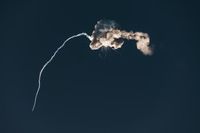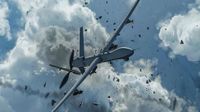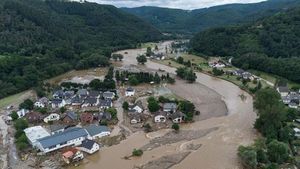In recent days, a series of drone attacks attributed to Ukrainian forces have raised concerns of escalated military confrontation in specific regions of Russia. According to the Russian Ministry of Defense, on March 23, 2025, a notable incident occurred whereby 59 unmanned aerial vehicles (UAVs) were destroyed, including one over the Saratov region. This event is part of a broader pattern of aerial assaults that have affected various Russian territories.
The UAVs targeted major areas, resulting in the temporary suspension of air operations at Saratov Gagarin Airport. Restrictions were implemented following the airstrike and were subsequently lifted early on March 23 at around 6:30 AM, a clear indication of both the threat and the preparedness of local air defense units.
Prior to this, the region faced a significant drone attack just days earlier, on March 20, which led to the downing of 54 UAVs in that vicinity. The frequency and intensity of these assaults indicate a disturbing trend in the ongoing aerial conflict, emphasizing the vulnerabilities present in airspace security protocols.
Reports emerging from multiple regions including Volgograd, Rostov, Voronezh, and Astrakhan describe a tumultuous night with explosions audible across these areas due to the UAV operations. The Ministry of Defense's account provided a breakdown of the intercepted drones: 29 were neutralized in Rostov, 20 in Astrakhan, and others in Voronezh, Volgograd, Kursk, and occupied Crimea. Eyewitness accounts highlight the persistence of drone activity, with citizens in cities like Kalach-na-Donu noting distinct sounds of UAVs overhead.
In Voronezh itself, Governor Alexander Gusev confirmed the destruction of over 15 drones, an escalation of attacks that has resulted in no casualties but led to property damage. This included explosions near essential industrial sites, causing alarm among local residents who are being urged to remain vigilant. The governor reiterated that any encounters with fallen drones should be treated with extreme caution to prevent any operational advantages for hostile forces.
The backdrop to this surge in drone activity includes earlier assaults targeting critical infrastructure. Notably, over the preceding weeks, a series of confrontations have played out, including attacks on the Volgograd region where minor damages were incurred, along with disruptions to the energy sector as drones struck oil and gas facilities.
There is a clear sense of urgency as Russian authorities seek to bolster their defensive measures in response to this aerial threat. Various regional governors, including Roman Busargin in Saratov, have alerted the public about potential future threats, advising them to stay indoors during air raid warnings.
Furthermore, observers note that these developments have compelled some regions, like Tatarstan and Yelnya, to likewise declare a state of alarm regarding drone threats, showcasing the widespread impact of the ongoing conflict and the resultant military readiness among local governments.
In a statement reflective of the gravity of the situation, officials stress the importance of united civilian vigilance alongside enhanced military efforts to contend with drone warfare. “Only through collective effort can we safeguard against our adversaries while our military executes their operations effectively,” suggests a military analyst familiar with regional security dynamics.
These incidents not only stir immediate regional anxieties but also signify deeper ramifications for security policies across Russia. The utilization of UAVs in combat is shifting paradigms in warfare, and how the Russian Federation adapts to these changes could define its military strategies in the unfolding landscape of geopolitical tensions.
The public's reaction varies; some citizens invoke a sense of community resilience while others express fatigue over the incessant security threats that plague their day-to-day lives. The compounding incidents of drone activity have forced local governments to strategize for immediate emergency responses alongside long-term security solutions.
In sum, while the military counters threats from Ukrainian UAVs, the inherent challenges faced by local populations underline the ongoing strain of conflict. The safety and preparedness of civilian spaces become a crucial conversation amid the rising aerial confrontations. As authorities continue their efforts at neutralizing these threats, the repercussions of such aerial assaults will remain a pressing focal point for regional stability.






